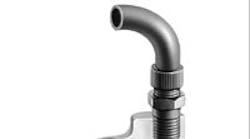With brakes, changes are evolutionary rather than revolutionary in nature. But however mature brake technology is, even moderate changes bring significant improvements.
Less is more
Brake designs are constantly testing the limits of physical size as designers work to fit them into continually shrinking spaces. In some cases, the brake must fit into a slot once occupied by a gear. And despite their small size, they must produce ever higher output torques.
Also, brakes are increasingly installed in hard to reach places. So there’s a need for units that can operate for long periods of time with little maintenance.
Many features that reduce maintenance used to be strictly custom requests. Now, however, you’ll find these features are becoming standard equipment. For example, self-adjusting brakes, that automatically compensate for friction lining wear, have become standard. And special gages, which provide a visual signal when air gaps need to be set, are common as well.
Sensors, switches, electronic actuation, heating elements, even special paints also show up as standard features. Many brakes now incorporate sensors that indicate whether a stopping mechanism properly releases. By signaling a PLC or PC, the sensor can prevent motors from starting should the operator fail to check brake status, say, following an unexpected power outage.
Heating elements reduce condensation, protecting brakes in enclosures as well as humid environments where moisture would otherwise shorten component life. Another level of protection, antifungal paint, is also becoming common.
Unlike their predecessors, brakes now arrive at the customer site ready to install and operate out of the box. Initial burnishing, where rotating friction discs are mated and worn against the stationary metallic friction surface, is usually done by the manufacturer. This step prepares brakes for inverter- controlled applications. Here, the brake usually sits at zero speed, and thus does not encounter conditions that would burnish it under load.
Two-second rule
You might think that inverterdriven motors reduce the need for conventional brakes. After all, inverters can closely regulate speed and offer dynamic braking. But there’s more to machine control than that.
In the machine-tool industry, for example, it’s the engage and disengage functions of clutches and brakes that are employed rather than their ability to control speed. This way, machine-tool builders don’t have to install motors and inverters on every shaft or spindle. Tapping machines, highspeed spindles, and multispindle equipment need such stop, start, and reverse control, in addition to speed control that’s best handled by the inverter. And as machines get more complex, designers are finding other opportunities for the standard “engage” and “disengage” action.
Although in some inverter-controlled systems there’s less of a demand for dynamic stopping, but still a need for holding, which is usually best met with a brake. A general rule is that if you have to hold a load for more than two seconds, you need a brake. And don’t forget, brakes serve as a backup when power is lost.
Sudden power loss is a serious issue. As inverters take machines to higher speeds, coming to a complete stop requires longer coasting time and distance because of the inertia. Not suprisingly, some inverter-driven applications that didn’t use a brake before do now.
The road well traveled
Brakes for vehicles are facing functional challenges of their own. Unlike machine brakes, though, these challenges deal with changing design intent.
Parking brakes used on offhighway vehicles are facing additional regulatory requirements. For example, they must now have dynamic stopping capability in addition to their original static function. Today, if a vehicle is moving at full speed and the main brakes go, the parking brake must be able to stop it within a certain distance. Making matters worse, regulations are continually shrinking the maximum stopping distance.
And then there’s the issue of weather. Parking brakes must be able to bring vehicles to a stop under any environmental condition. And sometimes, they must be able to repeat the process a specific number of times. On top of this, they have to fit into shrinking spaces, producing ever more torque, just like their industrial counterparts.
The similarities between industrial and automotive brakes often mean that developments in one area will eventually make their way into the other area. And lately, there have been several positive developments. Just recently, for example, designers discovered that brake bearings and shafts are not immune to thrust loads. Consequently, designers are turning to taper bearings for their ability to handle such loading.
And a common device in industrial applications,”wet” brakes are increasingly specified for offhighway vehicles. Wet brakes are better able to dissipate heat generated from stopping. Plus, they can be sealed to keep out dirt. In addition, since they work with transmission oil, they’re frequently being incorporated into transmission systems, which helps keep space needs to a minimum.
Information for this article was provided by Vaikai Brown, senior product engineer, Ausco Products Inc; Jim Fisher, general manager, Airflex Div., Eaton Corp.; Mike Sipek, division president, Jim Klann, field service manager, Gene Poker product manager, and Gary Lunzmann, manager - Marketing Development/ Administration, Sterns Div., Rexnord Corp., and Mike Mc- Donald, product specialist Clutches/Brakes, TB Woods.



